
HMAS Adroit was an Attack-class patrol boat of the Royal Australian Navy (RAN).
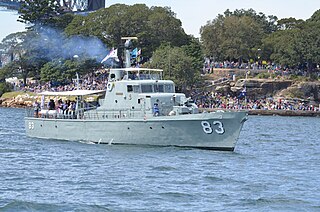
HMAS Advance was an Attack-class patrol boat of the Royal Australian Navy (RAN). Constructed during 1967 and commissioned into the RAN in 1968, Advance operated from Darwin and patrolled northern Australian waters.
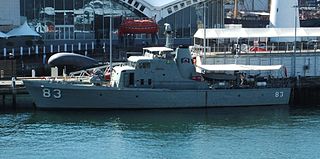
HMAS Aitape was an Attack class patrol boat of the Royal Australian Navy (RAN). It was named for the small town of Aitape, Sandaun Province, Papua New Guinea. Completed in 1967, the vessel was one of five assigned to the RAN's Papua New Guinea (PNG) Division. The patrol boat was transferred to the Papua New Guinea Defence Force in 1974 as HMPNGS Aitape. She remained active until 1982, when she was removed from service for use as a parts hulk. Aitape was scuttled off Port Moresby for use as a dive wreck in 1995.
HMAS Archer was an Attack class patrol boat of the Royal Australian Navy (RAN).

HMAS Ardent was an Attack class patrol boat of the Royal Australian Navy (RAN). She was built by Evans Deakin and Company, and was commissioned into the RAN in 1968. Ardent was decommissioned in 1994, then assigned as a navigation training vessel. At the end of 1998, she was removed from service. Initially marked for preservation at the Darwin Military Museum, the vessel was sold into civilian service in 2001 after the Northern Territory government declined. In 2002, the patrol boat was acquired by the Indonesian Navy, and commissioned as KRI Tenggiri (865) in 2003.

HMAS Arrow was an Attack class patrol boat of the Royal Australian Navy (RAN).

HMAS Assail was an Attack class patrol boat of the Royal Australian Navy (RAN).

HMAS Attack was the lead ship of the Attack-class patrol boats used by the Royal Australian Navy (RAN). Launched in April 1967 and commissioned in November that year, the ship was largely commercial in design and was used to protect fisheries in Australia's northern waters, and to support the survey ship Moresby. The vessel remained in RAN service until 1985 when it was transferred to the Indonesian Navy and renamed Sikuda.
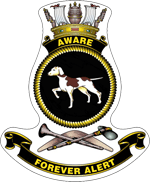
HMAS Aware was an Attack-class patrol boat of the Royal Australian Navy (RAN).
HMAS Bandolier was an Attack-class patrol boat of the Royal Australian Navy (RAN).
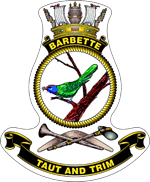
HMAS Barbette was an Attack class patrol boat of the Royal Australian Navy (RAN).
HMAS Barricade was an Attack class patrol boat of the Royal Australian Navy (RAN).

HMAS Bayonet was an Attack class patrol boat of the Royal Australian Navy (RAN).
HMAS Bombard was an Attack class patrol boat of the Royal Australian Navy (RAN).
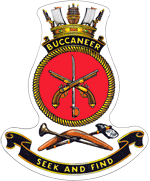
HMAS Buccaneer was an Attack-class patrol boat of the Royal Australian Navy (RAN).

HMAS Ladava was an Attack class patrol boat of the Royal Australian Navy (RAN). It was named after the small village of Ladava situated on the shore of Milne Bay in Alotau District, Papua New Guinea. Completed in 1968, the vessel was one of five assigned to the RAN's Papua New Guinea (PNG) Division. The patrol boat was transferred to the Papua New Guinea Defence Force in 1974 as HMPNGS Ladava. The patrol boat was decommissioned in 1988, although her fate is unknown.

HMAS Madang, named for the settlement of Madang in New Guinea, was an Attack class patrol boat of the Royal Australian Navy (RAN). Completed in 1968, the vessel was one of five assigned to the RAN's Papua New Guinea (PNG) Division. The patrol boat was transferred to the Papua New Guinea Defence Force in 1974 as HMPNGS Madang. She was decommissioned in 1989.

HMAS Samarai, named after the island of Samarai and its former town, was an Attack class patrol boat of the Royal Australian Navy (RAN). Completed in 1968, the vessel was one of five assigned to the RAN's Papua New Guinea (PNG) Division. The patrol boat was transferred to the Papua New Guinea Defence Force in 1974 as HMPNGS Samarai. She remained in service until 1987, when she was paid off and used as a parts hulk.

HMAS Lae was an Attack-class patrol boat of the Royal Australian Navy (RAN). It was named for the city of Lae, capital of Morobe Province, Papua New Guinea. Completed in 1968, the vessel was one of five assigned to the RAN's Papua New Guinea (PNG) Division. The patrol boat was transferred to the Papua New Guinea Defence Force in 1974 as HMPNGS Lae. She remained in service until 1988.
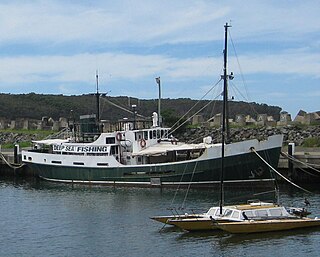
HMAS Banks was an Explorer class general-purpose vessel of the Royal Australian Navy (RAN), serving in a range of capacities from 1960 until 1995. She was named in honour of Sir Joseph Banks, the botanist aboard HM Bark Endeavour during the discovery of the eastern coast of Australia in 1770.









